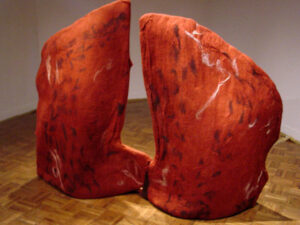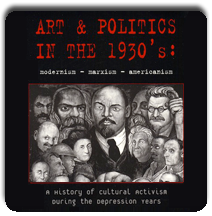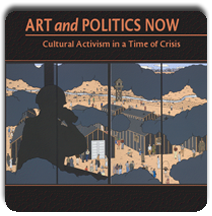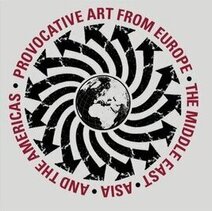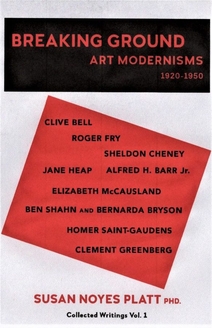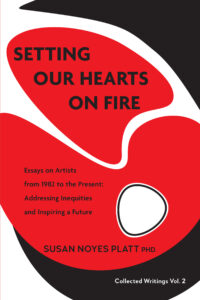Indigenous Knowledge and Climate Change
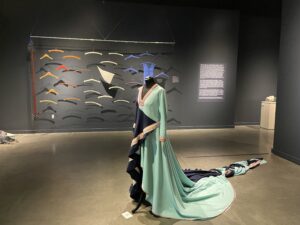
Laila Susanna Kuhmunen When Two Become One Installation with kolt traditional clothing, 2019
Finally, museums are offering us exhibitions that directly address climate change. “Arctic Highways” at the National Nordic Museum, until November 26, features twelve Indigenous artists from the circumpolar North (Sápmi, Canada, and Alaska) who address “the silent and the silenced knowledge” of their Sámi culture.
Laila Susanna Kuhmunen opens the show with her installation of a traditional kolt garment, formerly for work, not festive.
In the background is a seasonal celebration with fabrics Mátki Sámi ja Sámi áigodagaid čađa (The Roadtrip through Sápmi and the Sámi seasons) by Gudrun Guttorm. She is editor, together with Harald Gaski and Katya Garcia Antón, of Let the River Flow. An Indigenous Uprising and its Legacy in Art, Ecology and Politics (Office for Contemporary Art Norway/Valiz Amsterdam, 2020).”Let the River Flow’ takes the eco-indigenous action against the construction of a hydroelectric power plant in the Altaelva river in Northern Norway during the late 1970s and early ’80s as its starting point. The series of massive protests led by the Sámi people grew into an unexpectedly broad movement of solidarity across society, in which artists played a pivotal role.
This book reflects on events at the time and their correlations with artists’ eco-actions worldwide today. It addresses the political, cultural, and artistic aspects, including political organising, new influences of indigenous thinking on contemporary politics, and the centrality of artists within these activities.”
“Despite their protests, the Norwegian Supreme Court ruled in 1982 that the government had the right to construct the dam and power station, and the project was completed in 1987”
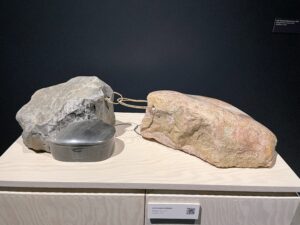
Laila Susanna Kuhmunen Steingiisá (Stone chest) Installation, stone, 2016
Laila Susanna Kuhmunen’s second work is a compelling stone sculpture from which a small polished chest emerges.
Máret Ánne Sara (below) comes from a reindeer-herding family in Kautokeino, Northern Norway, and currently works in her hometown. Sara’s work deals with the political and social issues affecting the Sámi communities in general, and the reindeer-herding communities in particular.”
But she is also involved with the international art community and showed in Documenta 14 in 2017 and will part of the Nordic Pavillion in Venice next year, which will now be a Sámi pavillion

Máret Ánne Sara (foreground) Moder Jord I (Mother Earth I) Sculpture made from a globe and scooter spring, 2015 Crowned by Foreign Fate (Background)

Máret Ánne Sara (detail)
![]()
“Arctic Highways” emphasizes common themes and shared concerns among Nordic cultures, beyond the artificial borders of nations. It began as an artist residency in Granö, Sweden and has now grown into a traveling exhibition and a book. The artists boldly experiment with a wide range of media, from traditional crafts to video art.
The idea of “arctic highways” creates connections between cultures: “Highways that are cultural and spiritual, real and thriving – but as invisible as the system of national borders that have imposed their rigidness and weight upon us, pitilessly trying to nullify the free flow of ideas and identity connecting our souls.” ( museum label)
Artists are from traditional reindeer herding families. They are acutely aware of the changes caused by warming weather, as well as alternative sources of energy filling open space. Wind turbines severely disrupt the grazing land of reindeer and melting snow alters migration and herding rhythms.
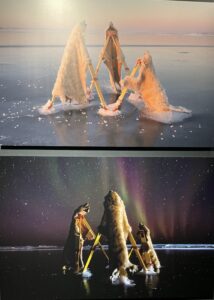
Aidainnaqduammi, Aurora Photo by Kyra Kordoski, print on aluminium
Maureen Gruber’s striking photographs of three polar bear skins titled Aidainnaqduanni (Inuvialuktun for ‘We are finally home’ ), Aurora, hanging on an abandoned survey tripod, looks like polar bears are climbing the tripods, then it becomes frighteningly clear that they are only skins. Her work here includes harp seal skin, red velvet, thread. She also works with “polar bear fur, beluga intestines and seal skins together with resins, vinyl, bubble wrap and metallic tape,” connecting the Arctic to ecological concerns.
“Throughout a week-long installation during winter freeze-up, sea ice gradually accumulated around the base of these assemblages, shifting the bears’ positions such that their gaze slowly tilted up towards the stars.”
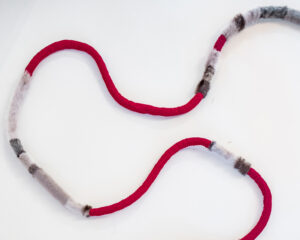
detail of Seal in Our Blood
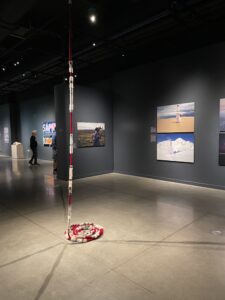
Maureen Gruben Seal in our Blood
Perhaps the most dramatic photograph in the exhibition is Meryl McMaster’s What Will I Say to the Sky and the Earth II, 2019 (in the series “As Immense as the Sky”):
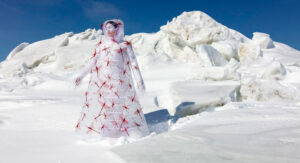
The artist stands against an Arctic landscape, wearing a protective coat with insects embedded. She states “Among the coastal ice flows of Lake Erie, I am covered by various insect species – members of a poorly understood and very important class of lifeforms. There are millions of insect species that are unknown to us, but play an important role in maintaining ecological equilibrium. To me they represent the fragile, harmonious balance that we are a part of and that we must take care to protect. Their silence is a warning that we are falling into a disharmonious condition.”

Tomas Colbengtson, Sápmi and Defaced
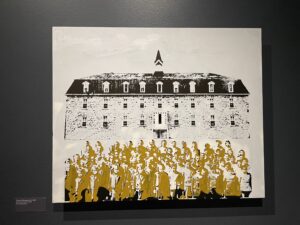
Tomas Colbengtson,Residential School
Works by Sonya Kelliher-Combs and Tomas Colbengtson address the subject of Church boarding schools in Alaska and Sweden that stripped children of their Indigenous Sámi culture. Colbengston featured in a previous exhibition at the Nordic Museum, Mygration, in whcih he collaborated with to create a moving installation about a strange project to bring reindeer and their herders to Alaska from what was then called Lapland.
https://www.artandpoliticsnow.com/2022/12/mygration/
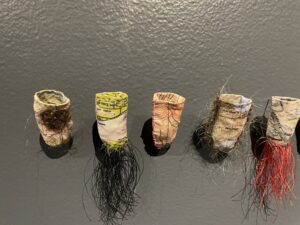
Sonya Kelliher-Combs’s Credible, Small Secrets, consists of 35 finger sized sculptures referencing abuse with human hair, nylon thread, glass beads, and steel pins. Each one refers to a village with credible reports of abuse. Colbengston’s painting is based on a photograph of a boarding school with the children lined up in front.

Laila Susanna Kuhmunen When Two Become One Installation with kolt traditional clothing, 2019
These artists of the polar North witness changes every day, as ice melts, temperatures rise, and animals and humans must change centuries old habits. The show is poignant, but also triumphant because the artists are both witnessing and resisting change.
*****************************************************
![]()

![]()
![]()
The Museum of History and Industry ( MOHAI), on Lake Union features an interactive exhibition “Roots of Wisdom : Native Knowledge, Shared Science” developed by the Oregon Museum of Science and Industry. Entirely interactive, it reaches out specifically to ages 12 – 14, but anyone can enjoy it.
![]()
“Each display highlights a different theme and tribe: “Reestablishing a Native Plant” (Eastern Band of Cherokees), “Restoring Fish Ponds,” (Hawaii), “Rediscovering Traditional Foods,” (Tulalip) and “Saving Streams and Wildlife”( Confederated Tribes of the Umatilla Reservation).
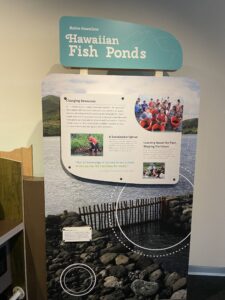
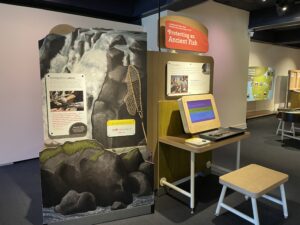
We can learn how to build a fish pond in Hawaii and or help preserve an ancient fish. The Lamprey, ( on the right) less glamorous than salmon, also suffer from the dams on the Columbia River. We can restore a river or learn why cane is better than grass near a river. We can weave a basket as we listen to traditional elders speak about caring for the land.
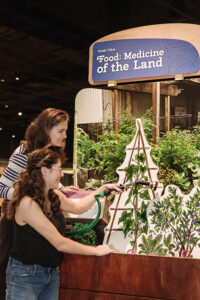
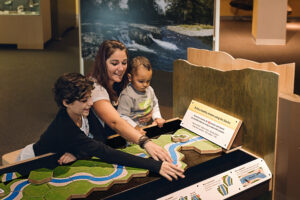
The MOHAI exhibit makes each pairing of contemporary science and indigenous knowledge easy to remember. Most striking perhaps was the section on “biopiracy” in which the question of patenting seeds is raised, a big issue in today’s world.
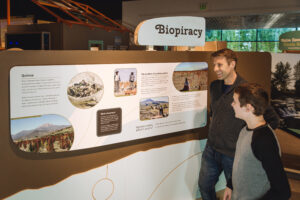
“Native Origins” suggests all the everyday products we use, like popcorn, that originally were created by Indigenous peoples.
We are fortunate to have both of these shows featuring Indigenous creative ideas that suggest a few ways to survive on the planet.
This entry was posted on October 23, 2023 and is filed under Uncategorized.
Latinx Performance Art, Men in Dance, and Indigenous People’s Day Celebration
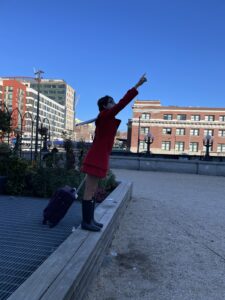
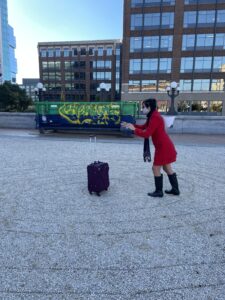
Dhyana Garcia’s pre show Butoh event outside King Street Station

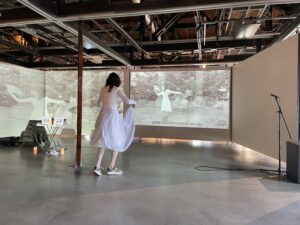
Tatiana Garmendia (IMG is movie) La Boveda: My Mother’s Kitchen IMG_3555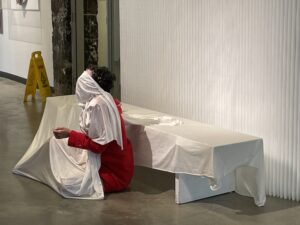
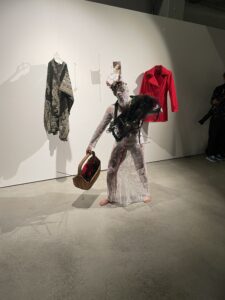 Dhyana Garcia Victoria@ King Street Station. THis was a long piece and she constantly metamorphosed.
Dhyana Garcia Victoria@ King Street Station. THis was a long piece and she constantly metamorphosed.
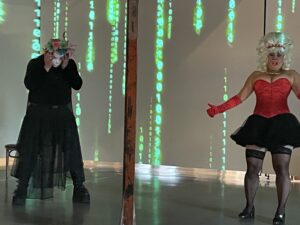
Xavier Lopex and Katherine Adamenko
Soft Cyborg meets the Beauty Borg
crazy costumes
Katherine Adamenko had a second piece called Shocked. I couldn’t photograph it, basically it was about having a shock treatment. She did a brilliant job of enacting that experience, but it was too much for me.
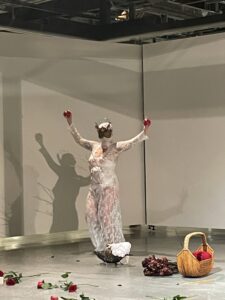
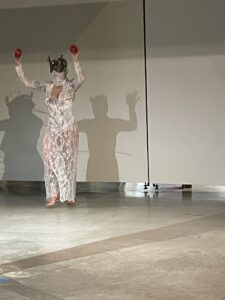
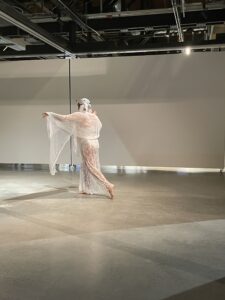
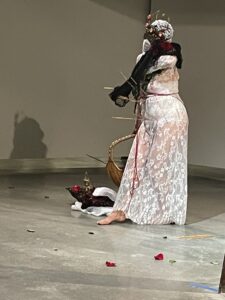
Sonia Aguilar Mourning Pomegrantes A Veiled symphony
If you look closely you will see she has arrows in her body. This piece ranged from lyrical to agonized.
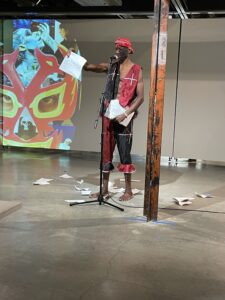

Santiago Vega performing on colonization
Last Friday, a type of performance/workshop with
Men in Dance, five choreographers. This was right before they started. Each one created a dramatic contrast of emotions. The man on the far right in the white shirt is a friend of mine, Bryon Carrr
Next to him is CHris Bell from New York, then in the background with long hair is Jet DogDog,(Long Branch California), Will Jessup and Bnjamin Defaria ( Vancouver BC) and Jameel Hendricks (Philadelphia) . the woman standing on the right was one of the three panelists who offered feedback on the performance.
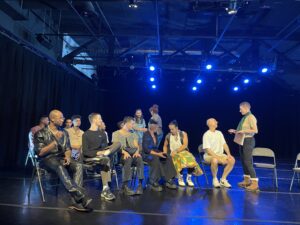
Next was Indigenous People’s Day a rally and march down
fifth avenue, celebrating and honoring elders.
There were tribes from all over, from Alaska to Mexico and many parts of the US. Where it says img with a number is a link to a movie.
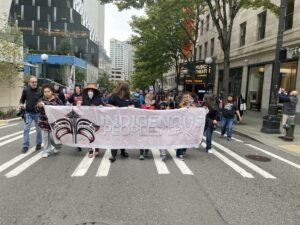
 IMG_3606
IMG_3606 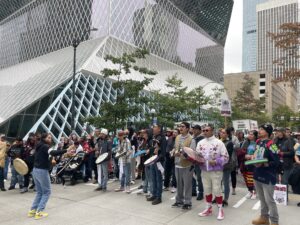 IMG_3609
IMG_3609 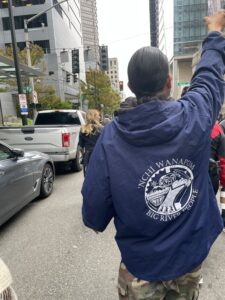
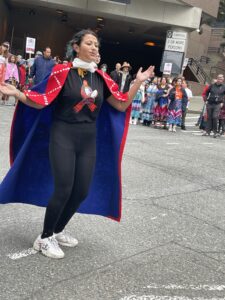
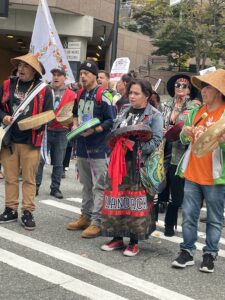 IMG_3620 IMG_3621
IMG_3620 IMG_3621 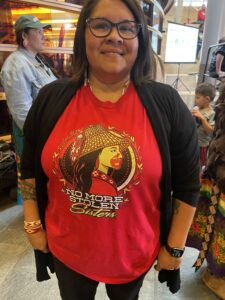
This entry was posted on October 14, 2023 and is filed under Uncategorized.
Gail Tremblay and Alfredo Arreguin
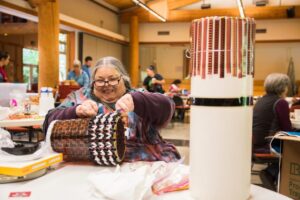
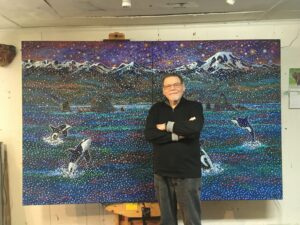
Memorials for Gail Tremblay (1945 – 2023), Alfredo Arreguín, (1935 – 2023)
This summer we had memorials for two special artists, both deeply concerned about our planet: Gail Tremblay, Native American poet and multimedia artist, and Alfredo Arreguín, Mexican and American painter. Gail Tremblay was a close friend for many years, I only met Alfredo once when I interviewed him for an article. The memorials were equally moving, although approached in different ways. In each case, I learned a great deal about the artists.
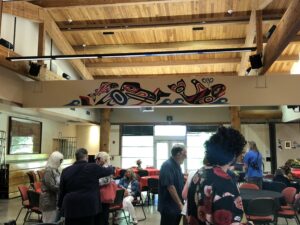
Gail Tremblay, of Mi’kmaq and Onondaga descent, was a long time professor at The Evergreen State College. The memorial took place at the House of Welcome Cultural Arts Center on the college campus. We heard about her huge role at Evergreen since the 1980s in creating a Native arts program, as well as mentoring students of all backgrounds. Called an “Artistic and Teaching Retrospective” it included testimonials to her importance as an educator, readings of her poetry, and a celebration of her art career.
I knew Gail mainly as a poet and a visual artist who addressed difficult topics in original mixed media formats.
The last time I talked to her, she read me some of her new poetry on the phone. What a wonderful experience. She was still writing in spite of many physical issues.
I have written about her art work for many years, as well as reviewing group exhibitions that she curated such as “Voices of Water” and “Not Vanishing. Contemporary Expressions in Visual Art.” Her striking installations addressed ecological disasters such as cancer from pollution at Hanford- “It is Heavy on My Heart,”
– and the loss of salmon-“Empty Fish Trap.”

She incorporated recorded narratives, video, photographs, and poetry into her installations.
She was best known for her film baskets woven from 35 mm film addressing the racism of Hollywood.
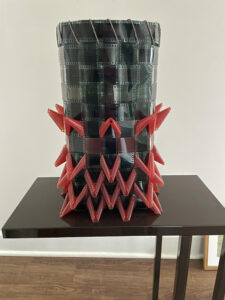
As I wrote in 2003:
“Gail Tremblay weaves our spirits into these artworks and takes us on a journey with her extraordinary technical ability, her words, her deep caring for the earth, and her sense of humor. On the journey we enter small worlds and large worlds, the outer universe and the inner universe. She hopes that we end up caring about all of it as much as she does.”
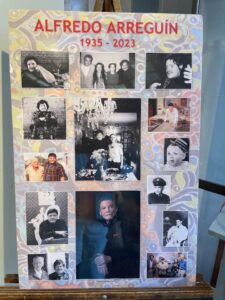
The memorial for Alfredo Arreguín on Whidbey Island at the Schouten Gallery featured an exhibition of his works in the gallery that surrounded us with his brilliant invocations of nature.
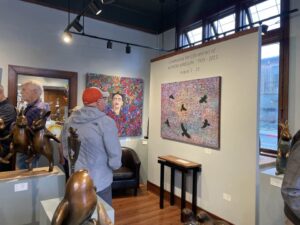
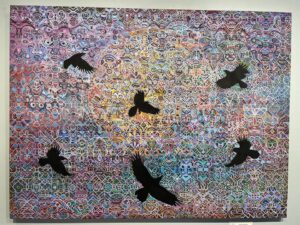
Arreguin started exploring the theme of Frida Kahlo many years ago, before she was a household name.

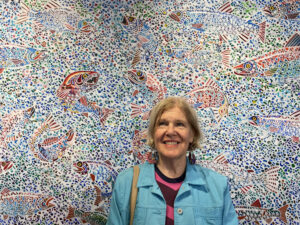
Arreguín’s painting is extraordinarily detailed, it includes layers of intricate patterns with faces emerging from them, or birds and monkeys immersed in deep jungle scenes.
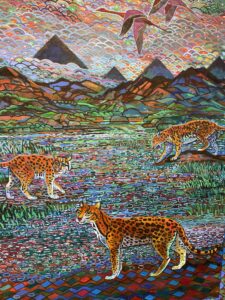
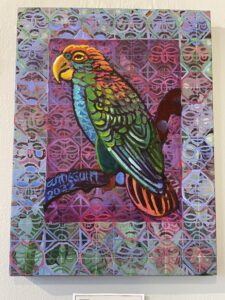
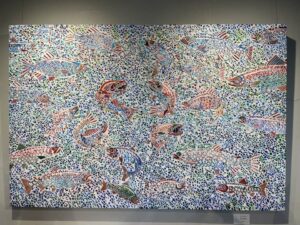
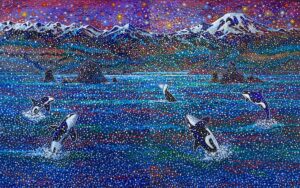

I took this photograph when I visited him for an article for South Seattle Emerald. they wanted too much rewriting, so I posted it on my blog instead.https://www.artandpoliticsnow.com/2019/08/a-visit-to-the-home-of-alfredo-arreguin-and-susan-lytle-june-2019/
I also included in my book, Setting Our Hearts on Fire.
While he talked to me, he turned around from time to time and added a dot to the painting. Here is a detail.
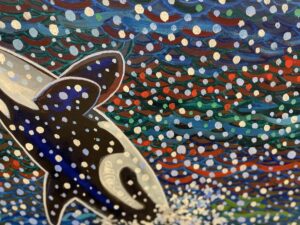
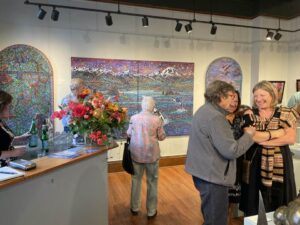
Arreguín’s paintings both celebrate and grieve for the loss of our rich biodiversity. As he stated, “We are the most dangerous animals on the planet.”
The next day the memorial featured informal statements by close friends in the garden of the gallery. The event was led by eminent poet Tess Gallagher. She and her husband, writer Raymond Carver (1938-88), were dear friends of Alfredo and Susan Lytle. Gallagher read “Reaching” a poem she wrote for him when he gave her the painting Green- Eyed Poet.
Lauro Flores, chair and professor of Ethnic Studies at the University of Washington and author of Alfredo Arreguín Patterns of Dreams and Nature spoke eloquently. Jeff Day, sculptor, and long time personal friend of Alfredo and Susan spoke about the Blue Moon Café, that famous bar in the UDistrict where many of Alfredo’s friends first met.
Both memorials honored the artists through the invocation of their lives and creativity. But what came across most clearly for both Alfredo Arreguín and Gail Tremblay was their vivid spirits, generous friendships, and extraordinary originality as creative people.
Arreguín painted leaping orcas in Puget Sound in several versions. Shortly after Arreguín’s memorial we heard of the death of Tokitae, an Orca captured on August 8, 1970 in Penn Cove, Whidbey Island the only survivor of hundreds captured. She spent her life in a small tank at the Miami Seaquarium. After many years of effort, she was about to be returned to her home pod in the Northwest.
Tragically, immediately after her death, the decision was made by the Aquarium to have Tokitae undergo an autopsy, so her body has been cut up. This is an additional shock to the Lummi since they weren’t consulted.
Now the Lummi have decided to cremate the remains and bring the ashes back home.
This entry was posted on August 28, 2023 and is filed under Uncategorized.
Jaune Quick-to-See Smith: Memory Map at the Whitney Museum
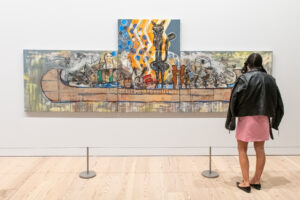
As we come into the installation of Jaune Quick- to- See Smith’s exhibition at the Whitney Museum, the first piece we encounter is the enormous Trade Canoe Forty Days and Forty Nights. 2015
named after the journey of Noah’s ark.
Trade canoes are a major theme in Smith’s work. In this exihbition we have eight, two actually built of pinewood lath with her son.
As an object in itself it can refer simply to a means of transportation and community connection (the importance and challenges of canoe journeys are now a prominent aspect of Northwest summers. Here is a report on the arrival of the canoes from all over the Northwest in Seattle n 2023, on Alki Beach, where the Denny party landed in 1850 greeted by Chief Seattle,)
But these trade canoes are already full to capacity with people, animals, trees, and imaginary creatures.
The artist states:
“Remember when the trade canoes came up river, they would be piled with bags of moldy flour, wormy beef, whiskey laced with lead and blankets smeared with smallpox” (p 21 Memory Map, interview with Lowery Stokes Sims)
So the trade canoes all suggest death related themes in some way.
Let us look at 40 Days and 40 Nights
It is impossible to take in all the details of even a single trade canoe and its contents. The larger theme is devastation of the land, the people, and the indigenous way of life that was stampeded by colonialism. A partner theme is the same colonial devastation is being perpetrated on the peoples of the Middle East.
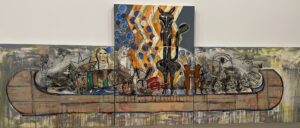
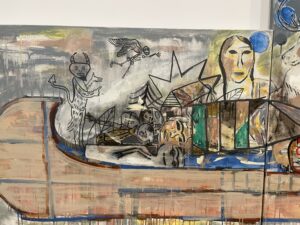
Left side ( bow??) we see the devil in outline;
above flies a winged calaveras ( where putti would be in baroque painting), a crowd of heads are collected one with a big “hat” like form
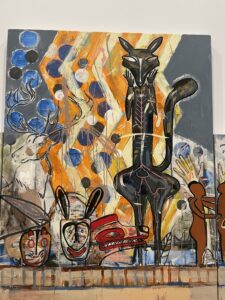
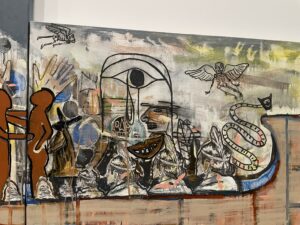
Center, Coyote part of Creation Myth, as well as trickster, near Coyote are various creatures, rabbit, eagle, deer. He is bathed in a shower of sun.
On the right we see two humans greeting each other and below a long row of cliche indian heads. A large picassoid head with one eye and a crooked mouth and a snake leaps up in the stern.
You can look at one of Smith’s paintings for a long time and not see everything.
She began the earliest canoe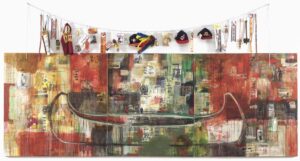
at the time of the 1992 celebration of Columbus arrival in 1492. Needless to say the arrival of Columbus was no cause for celebration among indigenous peoples. So this first canoe called Trade Gifts for Trading Lands with White People is full of amusing details, such as all the “gifts” strung across the top of the painting are Indian themed kitsch. Also the canoe has nothing in it unlike all her other canoes. and has no indication of front and back.
The canoe is suspended in a sea of collage that speaks to the abuses and contradictions of native life.
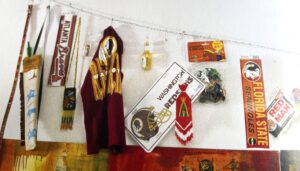
It is hard to see the collaged details in the painting, but they refer to various iconic images from the era of the Indian Wars such as Wi-jún-jon, Pigeon’s Egg Head (The Light) Going To and Returning From Washington, 1837-1839 by George Catlin. In this famous painting Catlin depicts the native Chief going to DC in his traditional regalia and returning with European clothes and whiskey bottles in his back pockets.
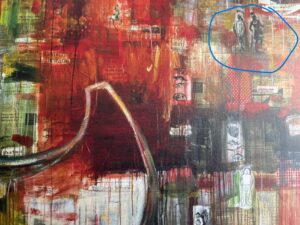
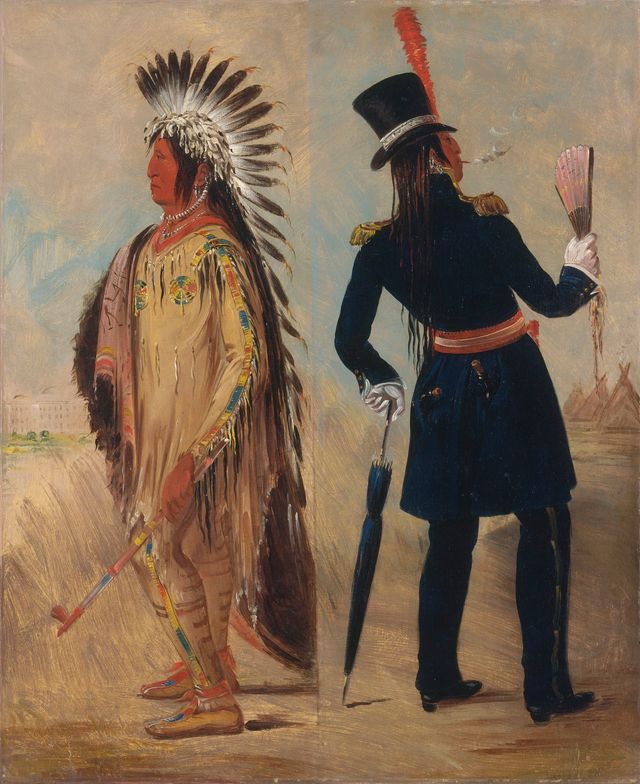
Tongass Trade Canoe 1996, another blockbuster painting refers to the bringing of oil drilling to the fragile Tongass National Forest, the calving land of the Caribou, whom we see galloping across the top of the painting. Above are laundry baskets suggesting a commodity that comes from oil drilling. The Tongass. after a decade of fighting, was finally protected in 2023 from development (we hope).
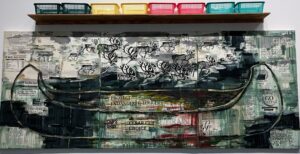


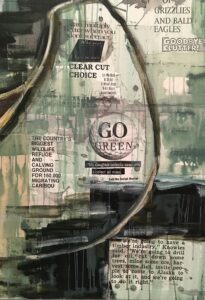
Here are more examples of trade canoes from the exhibition
Trade Canoe the Garden
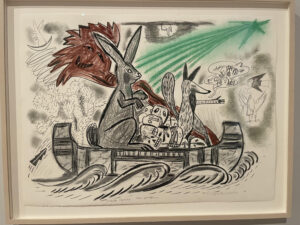
Trade Canoe Making Medicine with Neil Ambrose Smith
pinewood lath, plastic water bottles, styrofoam and paper coffee cusps, and take-out containers, wooden crosses, hypodermic needles, arcylic and synthetic sinew.
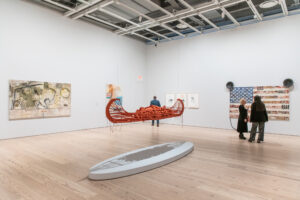
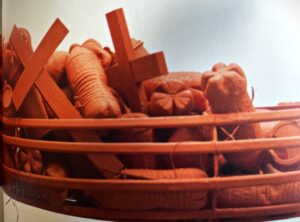
A detail of a second canoe Trade Canoe: Fry Bread 2018 pinewood lath, fry bread and synthetic sinew.
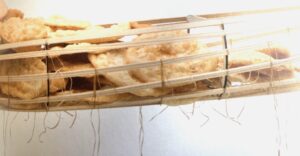
In other words one canoe has the detritus of consumption of a mainstream diet, the other has one staple of Indigenous food.
Trade Canoe for the North Pole What do you take when you have to leave everything. Smith humourously suggests Palm trees, but also a horse.
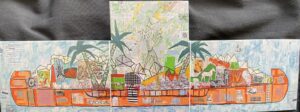
Trade Canoe False Gods
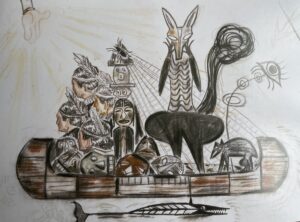
Trade Canoe: Don Quixote 2 details
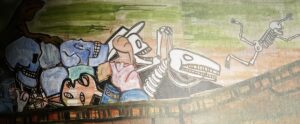
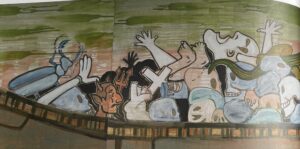
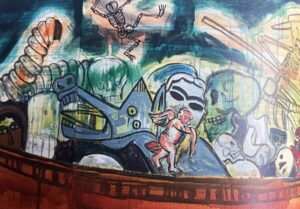
and Trade Canoe Don Quixote in Sumeria detail
Clearly we are seeing death and destruction, suffering, and chaos in these canoes. In the last, created in response to the Iraq war, we see a reference to a looted art work from the Baghdad Museum rubbing up against a skeleton, and a monster creature underneath that echoes Picasso.
One of Smith’s great accomplishments is to take on the big famous white artists and, in my opinion, outdo them at their own game adding much more meaning to the work. Picasso is one example.
The maps in the exhibition were initially inspired by Jasper Johns, but look where the artist goes with them. These are only three examples of many.
Indian Map
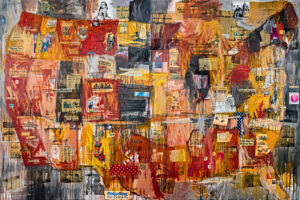
Memory Map
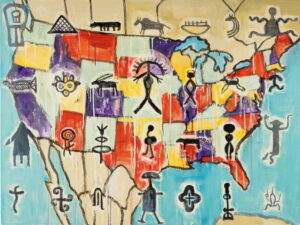
Homeland
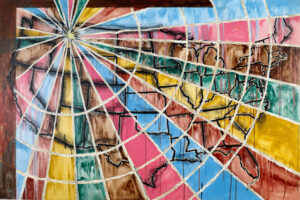
Look closely, the artist is from Montana in the upper left, there is a US map underneath, the radiating lines and colors create an entirely new dynamic.
Smith dismisses the traditional lines of US maps, the states, as arbitrarily cutting across Indian lands and tribes. In fact borders of any kind are arbitrary colonial demarcations.
Other icons in her work are horses
Going Forward Looking Back
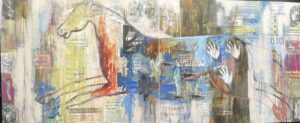
and buffalos
this painting is called Indian Drawing Lesson After Leonardo.
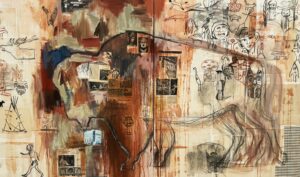
Again in the detail, you can see some famous Greek sculpture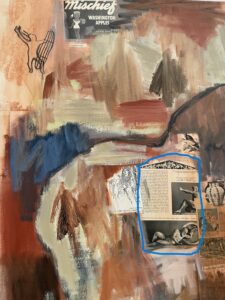
Smith’s show includes numerous icons, witticisms, re-ups of famous artists like Edward Kienholz
and Christianity with Indian Madonna Enthroned
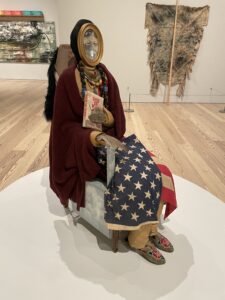
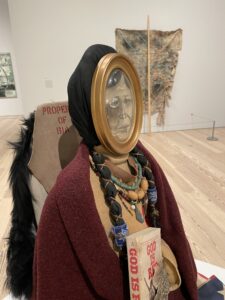
a whole series on General Custer, this is my favorite.
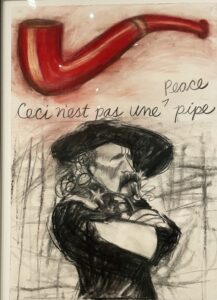
Send up of the thirst for Indian artifacts by white collectors
“Flathead Headdress collected by whites to decorate homes”
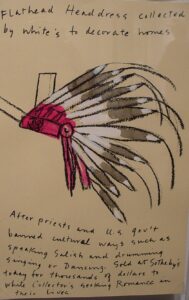
“After priests and US Government banned cultural ways such as speaking Salish and druming singing or dancing.
Sold at Sotheby’s today for thousands of dollars to white collector’s seeking Romance in their lives.”
One of Smith’s amazing talents is taking the dreadful and making it amusing even as we don’t lose sight of the horrors. I think this is called Indian humor.
Fortunately the exhibition is coming to Seattle in the spring, so I will get to write about it again with different perspectives. I feel as though I have barely begun.
This entry was posted on July 18, 2023 and is filed under Uncategorized.
Michelle Kumata What We Carry/ O que nós carregamos
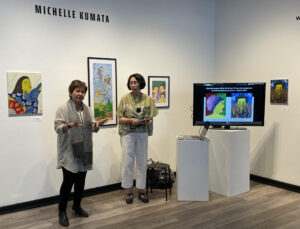
Michelle Kumata (right) with Cora Edmonds (left), founder of Artxchange Gallery, now ArtX Contemporary, at the beginning of Michelle’s gallery talk in her exhibition “What We Carry/ O que nós carregamos”
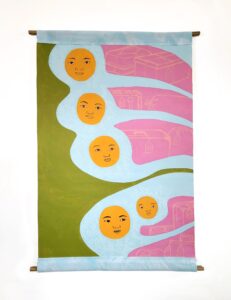
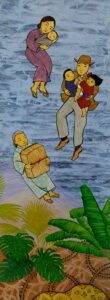
The story is fascinating. Kumata’s great grandmother went to Brazil in 1927 with all but two of her children. Michelle’s grandmother married and came to the US in 1918.
On the right is “Queda (Fallling)” an evocation of the experience of migration for her family in Brazil, her great grandmother is near the bottom, with other family above. They float through the air and are about to land in the lush countryside. Kumata commented that her great grandmother made this migration when she was in her mid 50s!
“This multi-generational family references the Japanese migration to Brazil: falling, blindly jumping into the unknown, with a jungle of tangled vines below. The strong vertical shape references Japanese scrolls.” ~ Michelle Kumata
They went to Brazil for work, but the agricultural work was, of course, very hard, and poorly paid and they lived in substandard sheds.
“What We Carry” on the left is described by the artist:
“When Nikkei families packed their belongings to go to camp, they were told to bring only what they could carry. A butterfly wing is patterned faces of younger generations. Outlines of suitcases represent the legacy we carry with us.” The outlines of the suitcases are barely visible in this image, in the pink area of the butterfly wings.

Crisântemo e Bananas (Chrysanthemums and Bananas)
“The chrysanthemum represents Japan. Bananas represent Brazil, farm labor, and also play on the term that some of the Asian diaspora are called, “yellow on the outside, white on the inside,” the results of assimilation. This is indicative of the complex identities of being Nikkei – being seen as the “Other” – not accepted as Brazilian enough, and also not accepted as Japanese enough.” ~ Michelle Kumata
The exhibition is probably the first time that an artist has brought together Japanese migrants’experiences in Brazil and in the US . We are familiar with our dreadful incarcerations. In Brazil the Japanese were stigmatized, but not incarcerated. They were not allowed to give their newborn children Japanese names. They were ridiculed for their food and appearance, and discriminated against in work.
(Currently, there is a reverse migration, as Brazil’s economy crumbles creating more layers of identities for the Japanese from Brazil who return to Japan. )
The story of Michelle’s family as seen in these beautiful art works is one of survival and endurance. The artist has carefully chosen motifs and colors to evoke various aspects of the cultural experiences in both Brazil and here. One of her themes is silence of the elder
generations, which resulted from racism and cultural oppression during World War II. Younger generations are now sharing these stories and speaking out against injustice.
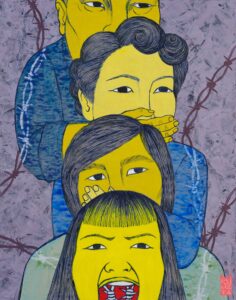
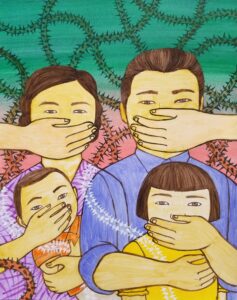
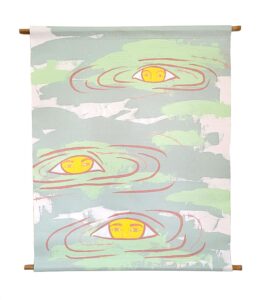
This painting called “Ripples,” also refers to the enforced silence, as these floating heads have no mouths. Michelle: “This silence and the invisible scars continue to reverberate through generations.”
With support from the Meta Open Arts Program, Kumata partnered with filmmaker Tani Ikeda to create a stunning multimedia “talking mural” last year. It celebrated the stories of the Bellevue Japanese farmers who worked land that was unusable with stumps after logging, and turned it into fertile farm land. They produced much of what was sold at Pike Place Market before the incarceration.

“Emerging Radiance Honoring the Nikkei Farmers of Bellevue “ with audio narratives from 3 Bellevue farmers from the Densho archives.The archives have a huge digital library
including over 900 video oral histories about the WWII Japanese American incarceration.
Much of this current exhibition is recent work, figurative images filled with symbolic references
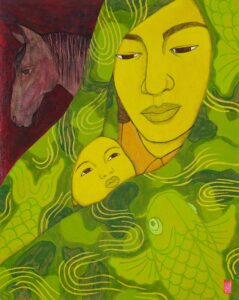
We see the horse in the background as a mother holds her baby in a blanket. It makes reference to the fact that the first stop during the removal of Nikkei (Japanese diaspora) in Washington State
was the Puyallup Fair Grounds, where people of Japanese descent were forced to live in the horse stalls.
Michelle:
“Mother cradles her child, wrapped in an Army blanket in their temporary home in horse stables at the state fairgrounds. She protects her baby from the effects of war, the hatred and racism, creating a camouflage shelter covered with carp, a symbol of strength, courage, patience and perseverance.”
You can see the carp on the blanket.
Moving to Brazil:
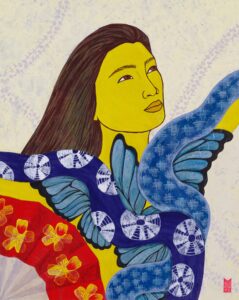
“Alcançar (Reach)” has a carefully chosen selection of patterns, each with specific meaning:
Michelle:
“The woman raises her arms, building strength from snakes and butterflies, as the brilliant blossoms of the Pau Brasil, the national tree of Brazil, dance on the folded fan. The shadows of crown of thorns branches fade behind.
What does it mean to be Japanese Brazilian? How does one navigate their own heritage, ethnicity and claim their own identity?”
The color of her face is intentional. We see a woman looking into the distance, buoyed up by the snakes and butterflies. It is a positive image, her expression is one of perseverence and hope.
Kumata paints with specifically chosen imagery in brilliant color so her artwork becomes a celebration at the same time that it is honoring the difficulties these people experienced.

Again we see thorns here in “Espinos (Thorns).”
“The Nikkeijin may be culturally, ethnically and linguistically Brazilian, but very often they are seen as ‘false nationals.’ With the economic success of Japan, the image has altered, but the Nikkeijin are still presented in the Brazilian media as ‘foreigners’ and not as Brazilians.” ~ From “Migrants and Identity in Japan and Brazil: The Nikkeijin” Daniela de Carvalho, 2003, p. 65
You might miss the meaning here without looking carefully. The color of the face is intentionally two toned, divided. Thorns pass over his face, and snakes fill his hat, but in the background we see a celebratory red and orange filled with butterflies.
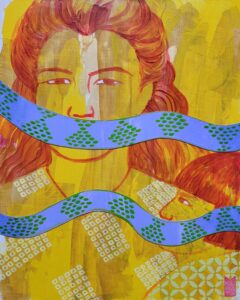
In “Cobras (Snakes),” 2021, the woman and child are silenced by the snakes, slithering across the foreground. This is again, the idea of silence.
From “Migrants and Identity in Japan and Brazil: The Nikkeijin.” Daniela de Carvalho
“Not being Japanese was particularly important, and although almost all Nisei had attended Nihongakko (Japanese language school), they did their best to forget what they had learned or to pretend they had never learned Japanese. It was believed that despite physical differences, not speaking Japanese and knowing little about Japanese culture would mean being identified (and accepted) as entirely Brazilian.”
This exhibition glows with color and pattern even as it gives us a history we know so little about in Brazil, and a new perspective on the incarceration experience here.
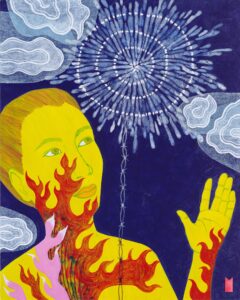
“Healing,” represents survival:
“Barbed wire flows from the heart, releasing a brilliant shibori firework. The verb “shiboru” means to wring, squeeze and press.” Fabric is twisted, folded, stitched and dyed in this intricate technique, resulting in beautiful, unexpected patterns. Hope flows as we find ways to heal.” ~ Michelle Kumata
This entry was posted on June 27, 2023 and is filed under Uncategorized.
Daniel Alexander Jones I Choose to Remember Us Whole (Altar no 3)
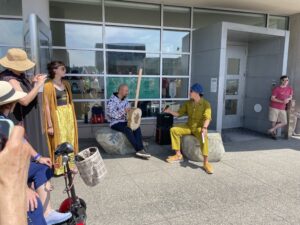
“I Choose to Remember Us Whole (Altar no 3)”, a project by Daniel Alexander Jones
On a sunny midday in May, I joined about 50 people for a procession sponsored by Meany Center for the Performing Arts that was part of “I Choose to Remember Us Whole (Altar no 3).” Daniel Alexander Jones, an artist, theatre artist, singer, performance artist, and educator, imagined the idea and invited Seattle artists to collaborate. The title suggests the purpose, healing by reconnecting to unseen forces.
The performance began at the Henry Art Gallery with the artist singing about wholeness, accompanied by Walter Kitundu playing a harp like instrument.
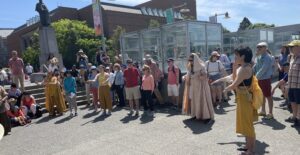
We were encouraged to wear earthy colors: I wore a bright green tee shirt from my Qi Gong class (which turned out to be the perfect prelude to the afternoon). A number of young women dressed in various shades of yellow began to dance. A drum beat signaled the beginning of the procession. As we passed through some trees the dancers reached to the sky then to the earth. It was a gesture familiar to me from QiGong, receiving positive energy from trees and giving stale energy back to the earth.
“I Choose to Remember Us Whole (Altar no 3)” is a new iteration of a project that Jones created at Cal Arts Center for New Performance called ALTARED STATES which:
“invites participants into an intentional relationship with unseen forces that shape our lived realities, including waves of history, culture, cosmology, and Soul. Altars have traditionally served as meeting places between the material and the numinous, among and across a range of cultures and artistic forms.”
Our invitation to wholeness embraced these forces. “What would it feel like to remember and to be remembered as whole beings? What would change? What would enable wholeness? And what can we do to embrace as whole what now seems irrevocably torn asunder? “
That’s the artist in yellow, and Valerie Curtis Newton on the left.
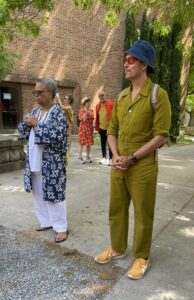
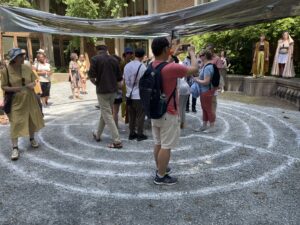
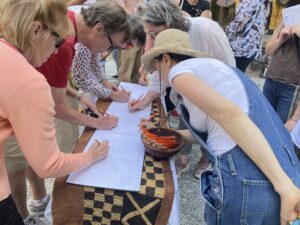
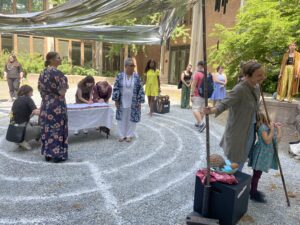
Valerie Curtis-Newton, the head of the Drama Department at UW,
greeted us at the “The Wisdom Walk”, in the courtyard of the art building. We were asked to take a prompt, walk a labyrinth and write in a book at the center of the labyrinth in response to the prompt. My prompt was “what do you wish someone had told you when you were five years old?”
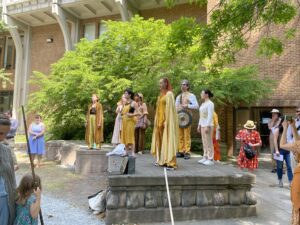
Diana Garcia-Snyder head of Dance department and her students
led us throughout the procession and performed periodically.IMG_2893
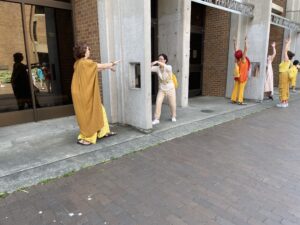
Our second stop “Altar to Interdimensional Entanglements” by Afroditi Psarra, a (Multidisciplinary Artist and Associate Professor, UW Digital Arts and Experimental Media DXARTS) intervened in a preexisting public art installation of metal chairs set in open metal structures. Afroditi (who is Greek – Aphrodite, Goddess of Love!) hung knitted fabrics as portals on the scaffolding of the outdoor rooms. Collaborating with AI (!) through prompts such as “black holes” and “warped passage,” she knitted patterns. Each hanging composed a different sound when we stroked the fabric.
That’s the artist dressed in yellow
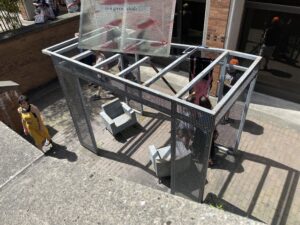
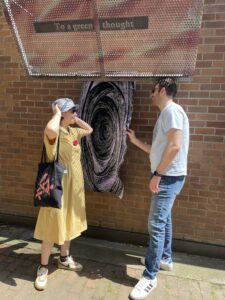
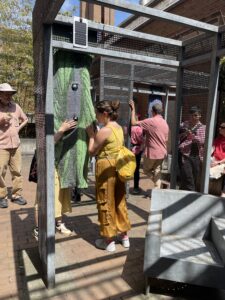
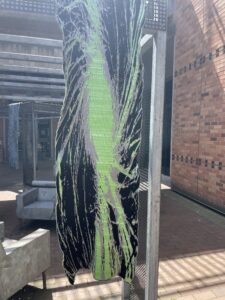
Not far away at Leon Finley’s “Altar to the Death of the Sun” we were asked to think for a minute about “what will we become when the sun burns out”. We faced West across this walll covered with dirt and spoke our answer out loud.
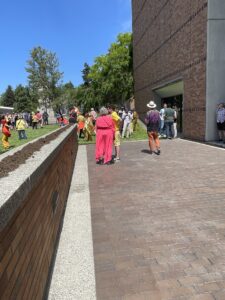

The fourth destination Altheo Rao’s “Chestful of Whispers” at the UW Farm near the southwest corner of the campus, focused on fertility with history, poetry and planting seeds.
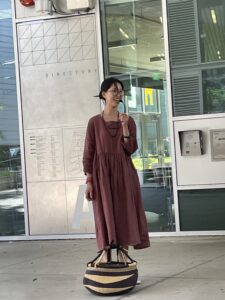
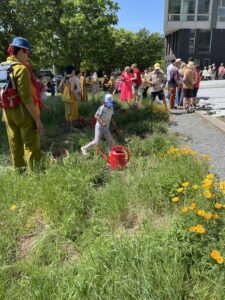
Then the procession wound its way to the end of Rainier Vista for the grand finale: Timothy White Eagle’s “Sacrificier Les Vivants” (sacrifice the living). White Eagle has long experience with ritual performances: we experienced death and resurrection through stories, and actions. Here IMG_2908 is a short clip. Finally, he offered us fireweed tea brewed from the first plant to grow back after a forest fire.
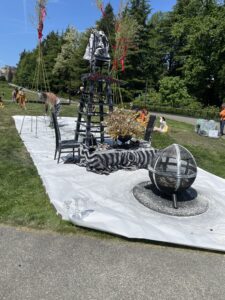
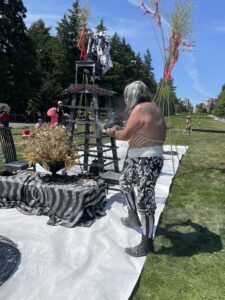
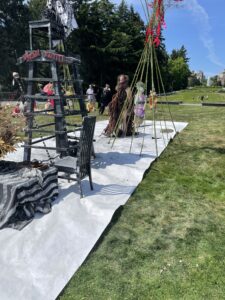

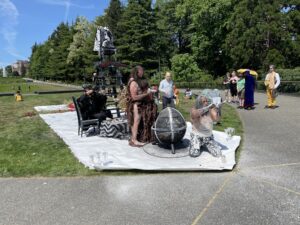


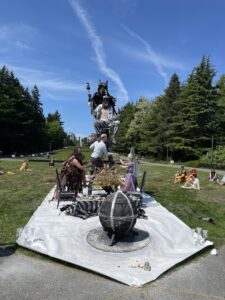
So we experienced a sequence of rituals that expanded our spiritual and emotional wellbeing. As a mystic, Daniel Alexander Jones seeks to collaborate in our recovery after the shattering events of the pandemic. Instead of presenting his own experience through art, we were expected to be part of the process of exploration.
Fortunately my Qi Gong practice works with unseen energy (Qi) in our organs, bones, and spirits: a good foundation for a procession to wholeness. I have not achieved wholeness of course, but this event was another step in the process.
Post script
Until July 9, the Henry Art Gallery displayed an altar that was the starting point for Altar no 3 ( sorry no image) , a collaboration with several artists from WaNaWari, expanded with parts of the five altars that we visited. You can contribute to this installation by writing about “what would it feel like to remember and to be remembered as whole beings? What would change? What would enable wholeness?”
The installations at the Henry Art Gallery included these artists , a [ublic participation piece well as WaNaWari artists 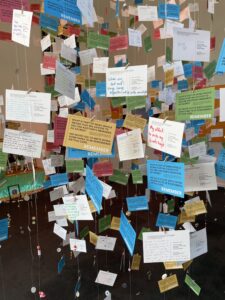
We responded with prompts and hung them on a “tree”

Inye Wokoma(WaNaWari) altar

Elisheeba Johnson (WaNaWari)
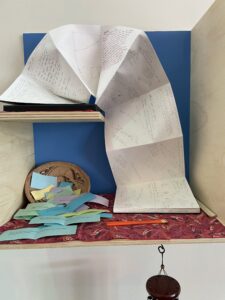
Valerie Curtis Newton, prompts and answers
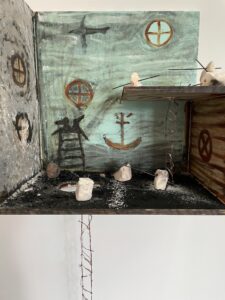
Timothy White Eagle
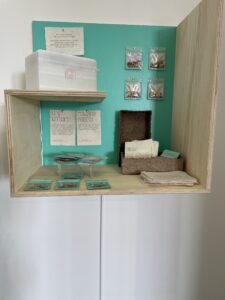
Altheo Rao
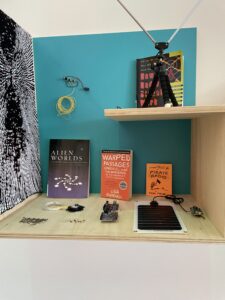
Afroditi Psarra

Leon Finley
This entry was posted on June 26, 2023 and is filed under Uncategorized.
Antelope, The Hop and Turner
In London Trafalgar Square on the Fourth Plinth we saw “Antelope”
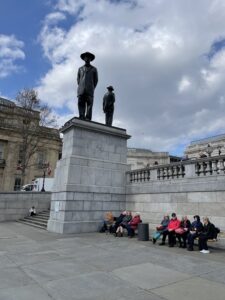
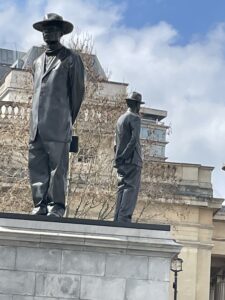
by Samson Kambalu from Malawi
It restages a photograph of a Baptist preacher and pan Africanist
John Chilembwe and European missionary John Chorley as a sculpture
“The photograph was taken in 1914 at the opening of Chilembwe’s new church in Nyasaland, now Malawi. Chilembwe has his hat on , defiying the colonial rule that forbade Africans frm wearing hats in front of white people. A year larter, he led an uprsisint against colonial rule. Chilembwe was killed and his church was destroyed by the coloonial police.
Chilembwe is larger than life, while Chorley is life-size, revealing the hidden narratives of underrepresented peoples in the history of the British Empire in Africa and Beyond”
The Hop
outside the Hayward Gallery we saw The Hop by Jyll Bradley
honoring working class Londoners who escaped the pollution of the city to be paid to harvest hops in rural England.
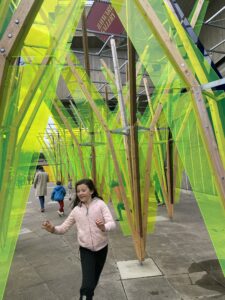
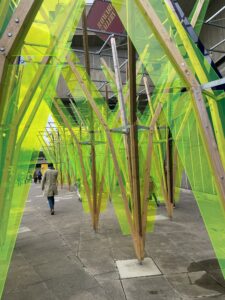
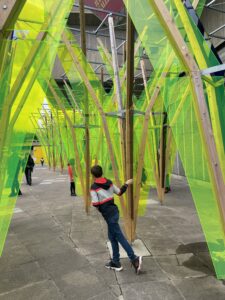
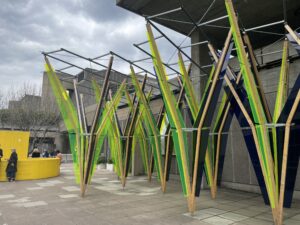
And finally, at the Tate Britain I end with JMW Turner whose images of disaster catastrophe, floods, fires, Destruction of Sodom, Snowstorm ( Hannibal crossing the Alps), The Flood, Whalers,
seem like where we are today!
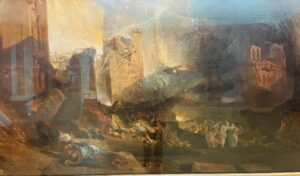
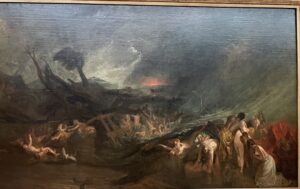
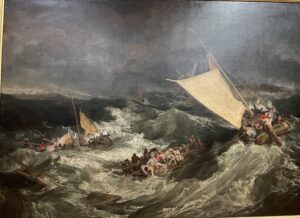
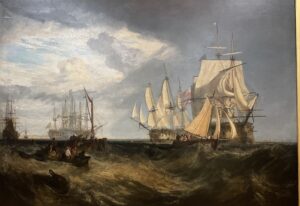
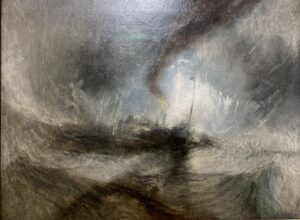
This entry was posted on May 30, 2023 and is filed under Uncategorized.
Contemporary Art in Cathedrals : Lincoln and Ely
On our recent trip to the UK to visit Henry’s wonderful familly, he wanted to visit two cathedrals, Lincoln and Ely. With a few logistical tricks and help from the family we made it to both! After we went I could see why he wanted to see them so much.
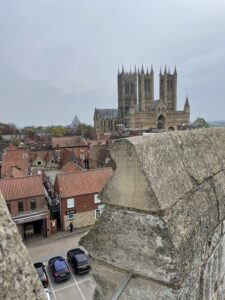
Here is Lincoln Cathedral, from the nearby castle, the interior and from the side. The Romaneque church was built by the Normans who apparently brought a lot of masons and other skilled workers with them. The city goes back to the Romans and has a few Roman structures .
It also has what I learned from a brochure was “The Secret Jewish Heritage of Lincoln.” It dates back to 1159, “second only to London in numbers, wealth, and scholarship,remaining prominent right up to the expulsion of the Jews from England in 1290” . Jews are readmitted to England under Oliver Cromwell, but in Lincoln a community didn’t reappear until late 18thc which lasted to mid 19th. Then many Jews came during World War II, but a community wasn’t reestablished until 1992.
Looking at the beautiful cathedral, we see Romanesque carvings on the West front, which we were told is meant to be the gates of heaven, and impress us, it is a portal to the sacred.
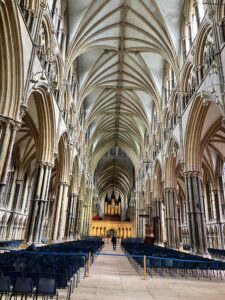
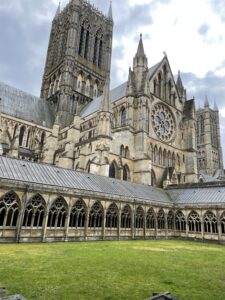
Across the entrance are a row of kings starting with Edward III. I like the one in the middle with his bare legs crossed, apparently that is King John who got a new leg. The kings receive authority from God.
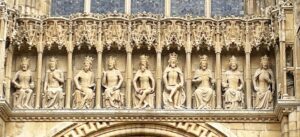
Here is a relief of devils seducing sinners and the original color scheme!.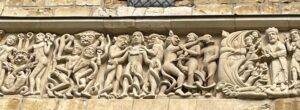
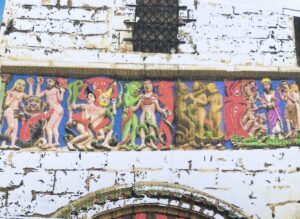
 Noah’s Ark
Noah’s Ark
Much as I love Romanesque sculpture, my real theme here is inside the Cathedral the Stations of the Cross by a contemporary artist. I thought they were really moving.
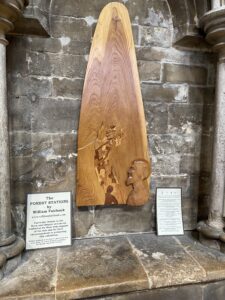
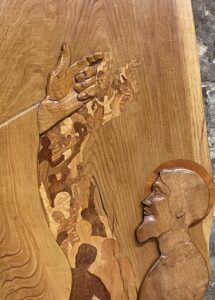
This is no 1 The whole series of Stations of the Cross, here called “The Forest Stations” were created by William Fairbank
“Jesus a Man of Truth is Condemned to Death by the crowd, through their government.”
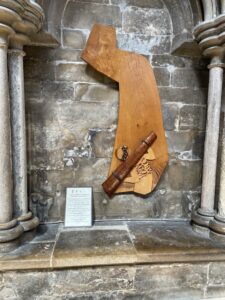
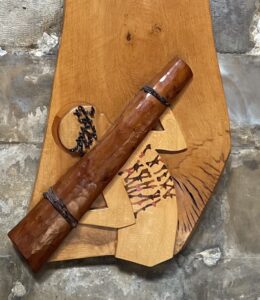
no 2 The truth is beaten and flogged and roped to the execution beam.
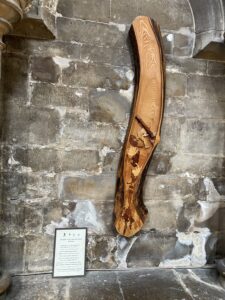
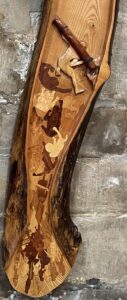
no 3
He falls under pressure from without

no 5 He is helped by his mother
You can see from these examples how moving each piece is.
Lincoln Cathedral also had a chapel painted by Bloomsbury artist Duncan Grant- theme is St Blaise, patron saint of wool gatherers
He included a lot of his friends! then the chapel was closed when the church discovered he was homosexual until 1990!
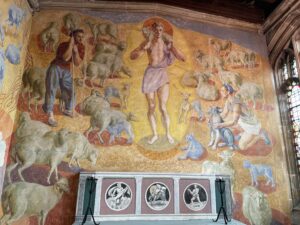
![]()
![]()
![]()

Ely Cathedral had a single piece of contemporary art at the entrance
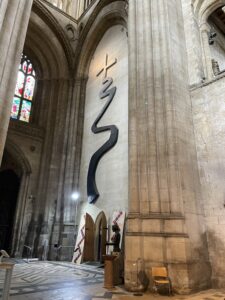
But the story of Ely is feminist! Founded by St Etheldreda! She was a Saxon princess married off for political reasons, but her first husband died and left her the land that Ely is on. Then she was married again to a Northumbrian Prince, but refused to consummate the marriage. He let her go to be a nun!, until his father died then as King he wanted her to start breeding, but she ran away!! went back to Ely, founded a monastery that later became the site of this cathedral.
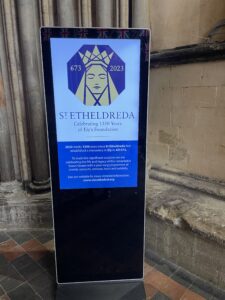
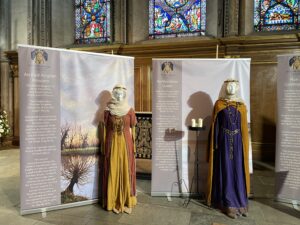
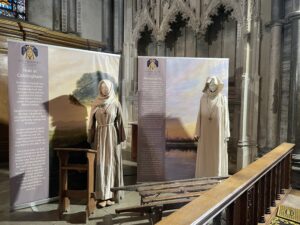
East Anglian Princess
Northumbrian Queen
Nun at Coldingham
( Northumberland)
Abbess at Ely
She never consumated her marriages so was able to be given sainthood! The church was visited by thousands of pilgrims honoring her.
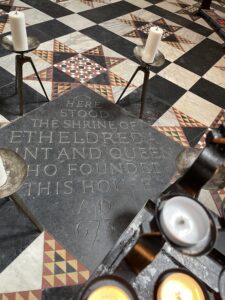
Here is the exterior
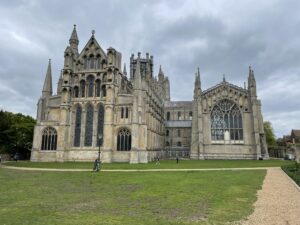
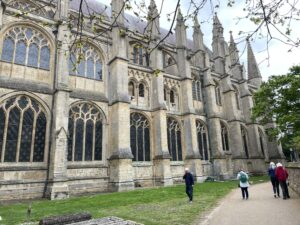
And the interior with the famous octagonal dome
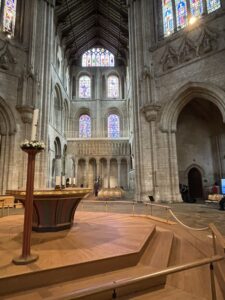
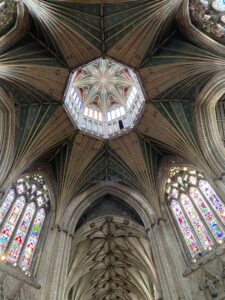
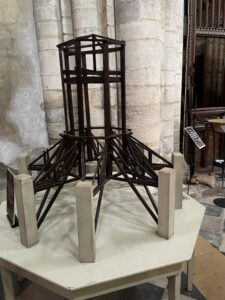
and its model

We left just two days before the coronation.
England was going crazy with paraphernalia
This entry was posted on and is filed under Uncategorized.
Nalini Malani at the National Gallery London “My Reality is Different”
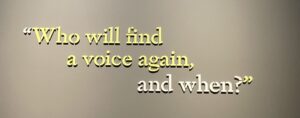
Nalini Malani’s immersive animated installation at the National Gallery London plunges us into a world of bizarre figures, creatures, and energy waves that swirl and constantly change shape as they invade the complacency of the people in famous European paintings, bit by bit . Nalini Malini
(That’s a clip from the installation. It has to be downloaded, but it is short)

Chosen for the first National Gallery Contemporary Fellowship, gave Malani the opportunity for a new direction in her multimedia work. She selected a group of 24 paintings from the National Gallery, London, and several from the Holburne Museum in Bath, then bascially attacked them with dramatic animation drawings created with her finger on an ipad.
The amazing complexity of pattern, color, texture and image speaks to the artist’s command of this new medium which she has been working in for several years in short animations that she posted on Instagram.
The animations are agitated, threatening and occasionally playful.
We see only fragments of the original works.
The result is a dizzying array of images that are in constant motion, accompanied by a sound track that is a long lament by Cassandra who predicted the Fall of Troy, but no one believed her. What better mythic character for our times, when no one is changing their ways as we approach the precipice of no return on our climate
The overall theme is an attack on colonialism and white patriarchy based on the idea that “My Reality is Different”
So for example
Johann Zoffany’s The Auriol and Dashwood Families 1783 to 87
an image based on a painting of three influential families in Bengal India. The man in the green jacket on the right receiving a letter was an administrator of the East India Company. It shows the hierarchy of wealthy white British and their Indian servants
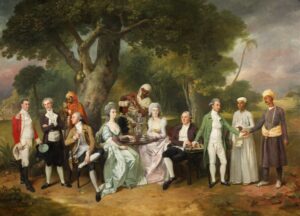

On the right you see clearly that same man with the green jacket, as well as some of the other members of his family, but the portrait is torn apart and basically undermined by Malani’s caricaturesque drawings.
Here is another example, harder to see. Caravaggio’s Supper at Emmeus and Malani overlay. You can see the detail of the Supper in the middle.
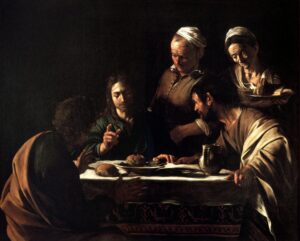
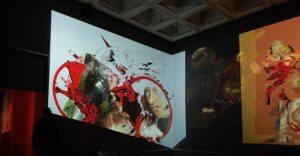
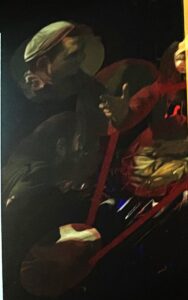
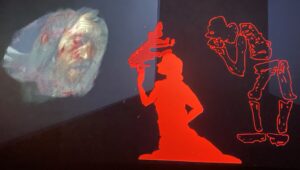

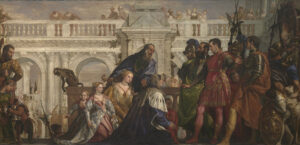
Nalini plucked the face of Darius from the huge painting by Veronese The Family of Darius before Alexander. The painting is an example of Alexander treating the defeated Persian king kindly, but the subject of course is imperialism as Alexander marched through country after country all the way to India.
Most of the source paintings Malini chose are examples of either arrogance, colonialism, or, in some cases feminism ( as in the Head of John the Baptist or Samson and Delilah).
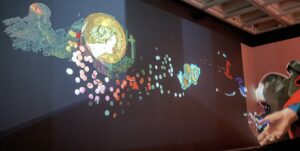
In the gold cirecle is only the head of the Angel Gabriel, half of an Annuciation scene from the 15th century.
Malani most frequently excerpts heads and hands from the original paintings, it is fun to spot them and trace them to the original works.
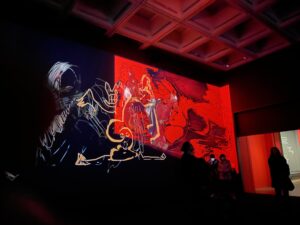
But of course that is so Eurocentric of me! The main point is the many many other figures that race through the video, and those shadowy portraits of people exist on the margins of this imperial world of white people.

As you immerse yourselves in the room, surrounded on four walls by animation, the dizzying array of images overwhelms us ( that is the point). The source images disappear or flash by in small fragments as we see their decimation and fragmentaion.
The installation is an attack on Western imperialism as seen in these paintings full of complacent white people, conquerors, rapists and even a scientist suffocating a bird.
The artist projected a 9 channel installation in what she called the “animation chamber”. Each channel had three looped videos of about 3 minutes each. In the catalog she lists all the source paintings, but she illustrates only the ghostly figures who have been added by the artists so the “subaltern can speak”
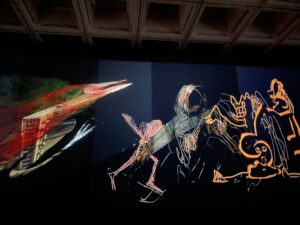
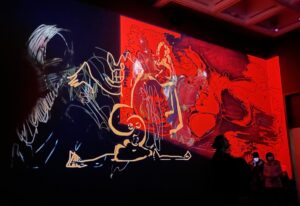
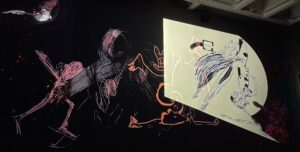
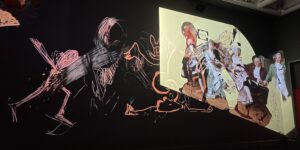
Here is a sequence that almost captures the effect of constant metapmophosis, you can recognize some repeated figures ( note creature in a heavy yellow outline, and running figure to left) and at the end the traces of that same painting by Zoffany of the East India families and their servants of color.
In addition to the layers of animations, the installation also includes a sound track, it of course is also consisting of several elements:
the sound of a sailing ship on the sea, “Rule Britannia” interrupted by a folk song sung by an Indian woman. Thefocal point, though, is the long chanted poem in the identity of Cassandra who is of course the prophetess of Troy who precidted its fall and no one believed her.
She could not be more pertinent today. ( it was adapted from Christa Wolf’s Cassandra:A Novel and Four Essays by the artist and Alaknanda Samarth)
This entry was posted on May 27, 2023 and is filed under Art and Politics Now, art criticism, Feminism, Uncategorized.
At the Tate Modern Part II Maria Bartuszová and Magdalena Abacanowicz
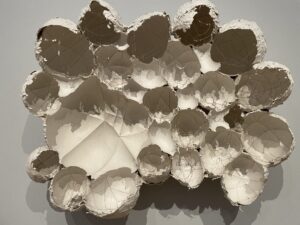
I just read an editorial by Eddie Chambers in the Art Journal, that women artists are still being slighted in the art world and by art historians. Price wise their art has much less value and they are not given the same attention in museums because, Chambers declares that curators say they are “in hock” to commercially successful contemporary artists.
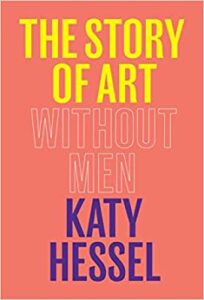
Hopefully that is changing. I saw this book The History of Art Without Men, for sale at the National Gallery, London, when I went there to see the amazing Nalini Malani exhibition ( more on that soon), and at the Tate Modern there were three major exhibitions of work by women.
The first is Cecilia Vicuna, just discussed above.
The work of the second artist Maria Bartuszová. (1936 – 1996)
you see at the top of this review.
A sculptor from Slovakia,
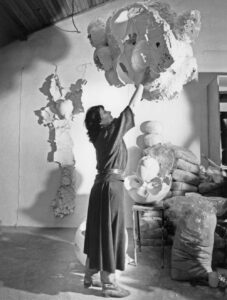
first a Communist country, then a former Communist country ( a monumental fact that is oddly omitted from her biography- as is much else) she was not seen in exhibitions outside her country during her lifetime.
Bartuszova’s exhibition is part of an initiative at the Tate Modern that includes Cecilia Vicuna and Magdalena Abakanowicz, presenting women artists who have revolutionised modern sculpture. All three of these artists are from outside the “Western” world, Communist Czechoslavakia-Slovakia, Peru – indigenous, and Poland also Communist.
Bartuszová is the least well known of the three artists. She was able to support herself under Communism with public commissions. But her public work was not ideological, but abstract.
She learned about mainstream art from books while she was living in Košice the second largest city in Slovakia, deep in central Europe not far from the border of Ukraine and Hungary. She moved there from Prague and its exciting intellectual community lured by possibilities of public art commissions in a rapidly expanding city, and inexpensive housing.
As she was raising her small children she had the idea of casting plaster over balloons., often submerging the forms in water in a technique she called “gravistiumlated shaping” as th weight of the plaster determined the shape of the sculpture.
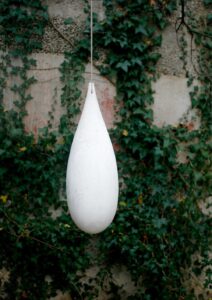
From there she began to blow into the balloons and poured plaster over them , she called it ‘pneumatic casting’ the result was a fragility that evokes eggs or shells.
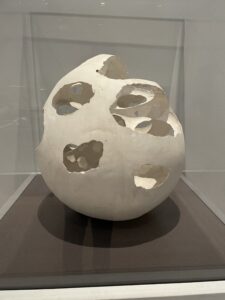 She also created temporary works in nature and later in her life hung her work in trees.
She also created temporary works in nature and later in her life hung her work in trees.
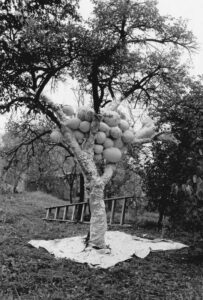
The playful quality of the work pairs with an intense feeling for nature and original forms that create a lyrical presence. She was familiar with Luca Fontana and Brancusi, and we see that in these works.
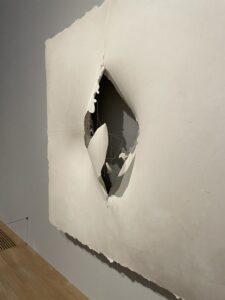
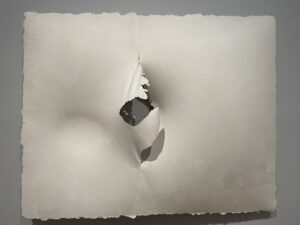
So we can place her in the cerebral, sensual category of contemporary sculpture, courting the line between abstraction and naturalism.
Magdalena Abakanowicz “Every Tangle of Thread and Rope”
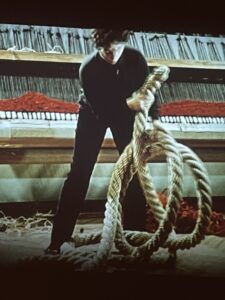
While Maria Bartuszová creates fragile intimate works, Magdalena Abacanowicz creates large muscular pieces made from sisal as well as horsehair and hemp. The works called “abacans” to indicate her originality (named after her) moved in her early career from the wall
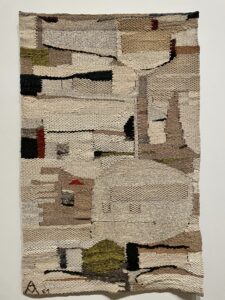
to the middle of the gallery, taking on a creature like presence. As we walk among them we feel the innate energies of nature. in this one we see a fibrous connection between two lung like shapes.
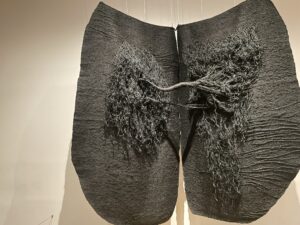
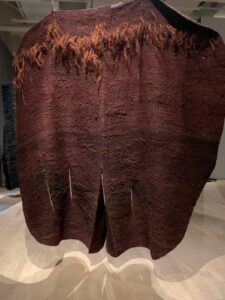
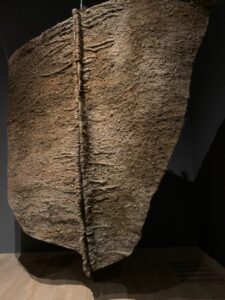
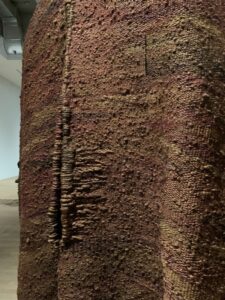
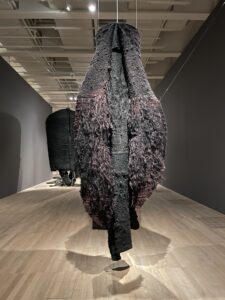
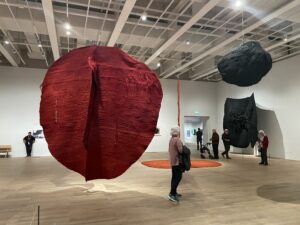
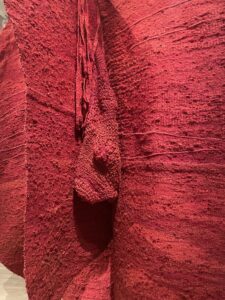
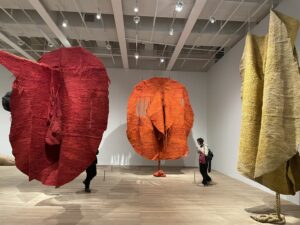
Abacanowica was born in 1930 to Tartar Russian Polish nobility, at the beginning of the war they retreated deep into the forest, then they lost everything. that experience in the forest deeply marked the artist, and she feels strongly the power of the forest.
In her late work she turned to trees themselves
“Arboreals symbolise our concern with nature, which neglected and abused by man, now turns against him with vengeance. They remind us that a tree is our friend; it gives shade and oxygen, bears fruit, shelters birds and animals and makes climate hospitable to all ”
“I use the tree as a metaphor for the ecological architecture of the 21st century, just as the human body served as a metaphor for the shape of a Romanesque cathedral. ”
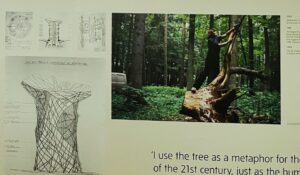
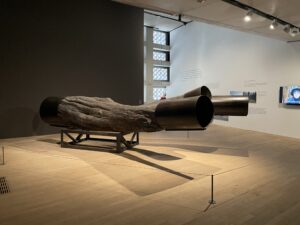
Both of these artists are immersed in nature, and concern for its future. Both grew up under Communism, but supported themselves as artists. Abacanowicz gained great esteem while Maria Bartuszova was unknown. I am thankful they are side by side now at the Tate, as it gives us in both cases a highly original approach to sculpture using organic materials.
This entry was posted on May 21, 2023 and is filed under Contemporary Sculpture by Women, ecology, Uncategorized.




